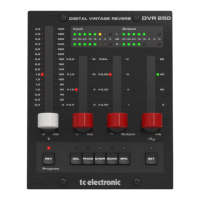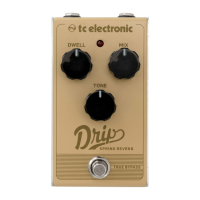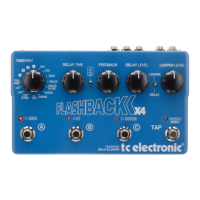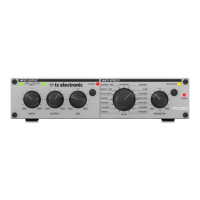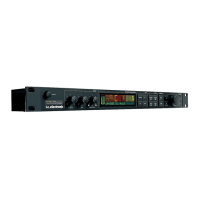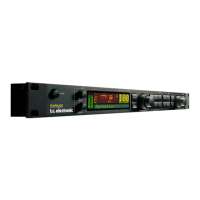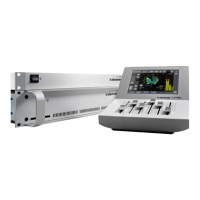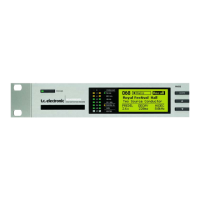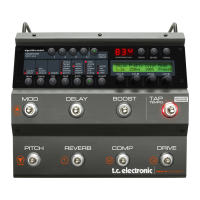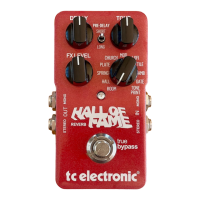Do you have a question about the TC Electronic D-TWO and is the answer not in the manual?
| Delay Time | Up to 10 seconds |
|---|---|
| Dynamic Delay | Yes |
| Tap Tempo | Yes |
| MIDI | In/Out/Thru |
| Form Factor | Rackmount |
| Rack Spaces | 1U |
| Sample Rate | 44.1 kHz, 48 kHz |
| Bit Depth | 24-bit |
| Type | Multi-tap Rhythm Delay Processor |
| Analog Inputs | 2 x 1/4" |
| Analog Outputs | 2 x 1/4" |
| Digital Inputs | S/PDIF |
| Digital Outputs | S/PDIF |
| Inputs | Analog, Digital |
| Outputs | Analog, Digital |
| Dimensions | 19" x 1.75" |
| Weight | 1.9 kg |
Comprehensive safety advice for operation, installation, and maintenance, including user responsibilities.
Critical warnings about electrical hazards, fire prevention, and correct voltage usage for safe operation.
Notes on modifications, user-serviceable parts, and when to seek qualified service personnel.
Details on the equipment's compliance with FCC and Canadian ICES-003 standards for electromagnetic interference.
TC Electronic's declaration that the D-TWO complies with relevant EU safety and performance standards.
Welcome and general description of the D-TWO as a high-quality, easy-to-use digital multi-tap rhythm delay unit.
Highlights the unit's traditional and new functions, including the "Dynamic Delay" feature.
Explanation of front panel controls like Power, Input Level, Mix, Input meters, and Overload indicators.
Detailed explanation of various display indicators and LEDs on the D-TWO front panel.
Details the functions of dedicated keys like Delay/Tap, Feedback/Rhythm, and the control wheel.
Explains the purpose of effect selection keys and function keys for editing, recalling, and bypassing presets.
Details the rear panel's analog and digital input/output connectors, MIDI, and pedal inputs.
Provides pinout diagrams for MIDI cables and balanced/unbalanced XLR connections.
Visual representation of the audio signal's journey through analog and digital processing stages.
Instructions on connecting the D-TWO using balanced 1/4" jack cables.
Explains the three primary delay modes: Traditional, Straight, and Rhythm.
Illustrates typical stereo and mono connection setups for the D-TWO with a mixer.
Detailed breakdown of all indicators and readouts on the D-TWO's multi-spectral LCD display.
Explanation of what each display element signifies, including delay timing, tempo, and preset information.
Explains indicators related to clock source, sample rate, and delay time units (milliseconds or BPM).
Details indicators for feedback levels, filter settings, and panning effects like PingPong.
Guide to navigating and modifying general setup parameters using the panel controls.
Configuration options for input type, stereo/mono selection, and clock source synchronization.
Settings for analog output levels, digital input gain, and dithering for audio quality.
Options for setting status bits, delay units (ms/BPM), delay mode (Stereo/Mono), and reverse offset.
Configuration for MIDI synchronization, channels, control changes, bypass modes, and pedal assignment.
Instructions on how to navigate and select presets for recall or previewing.
How to access and modify delay-specific and additional effect parameters for sound customization.
Steps for saving edited presets, including options for naming and location.
Explains the standard delay operation, its feedback loop, and methods to engage this mode.
Details the Straight Delay mode, its multi-tap strategy, and parameter controls.
Introduces the Rhythm mode for tapping and controlling custom rhythms.
Further explanation of the Straight Delay mode's feedback strategy and multi-tap approach.
Parameters for controlling delay time and feedback level in Straight Delay mode.
Lists additional effects that can be applied to the Straight Delay mode, with references to further details.
Details controls for the number of repeats and adding shuffle feel in Straight Delay.
Explains quantization, tempo tracking, rhythm decay, and subdivision settings for Straight Delay.
How to enter and operate the Rhythm mode by tapping rhythms into the unit.
Parameters for setting tempo, decay, and number of taps in Rhythm mode.
Explains shuffle, quantization, and tempo tracking features within Rhythm mode.
Explains different decay styles (Normal, Step) for rhythm patterns and their effect on repeats.
Detailed guide on editing individual taps within a rhythm pattern, including level and timing adjustments.
Further explanation of reverse delay styles and their trigger mechanisms.
Lists useful shortcuts for navigating menus, editing parameters, and switching modes quickly.
Details the Spatial effect for widening stereo image and Filter effect for tone shaping.
Explains the parameters for the Chorus effect, including speed, depth, feedback, and timing.
Advanced settings for the Chorus effect, including Golden Ratio, phase reversal, and LFO shaping.
Details how the D-TWO responds to various MIDI messages and functions.
A comprehensive list mapping D-TWO parameters to specific MIDI CC numbers for external control.
Specific MIDI CC assignments for controlling rhythm tap time and level.
Detailed specifications for digital and analog input/output formats, levels, and frequency response.
Technical details on EMC compliance, safety certifications, environmental conditions, and physical characteristics.
A list of all 50 factory presets with their names and corresponding location numbers.
